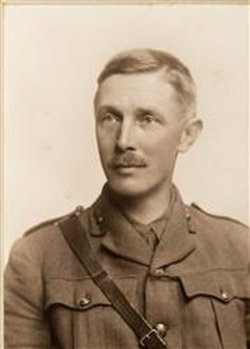
Figure 1. Major Harry Clissold, R.E.
(Image from Wycliffe College and the War)
Major
HENRY “HARRY” CLISSOLD
Royal
Engineers
By
Lieutenant Colonel (Retired) Edward De Santis,
MSCE, PE, MinstRE
U.S. Army Corps of Engineers
(June 2023)

Figure 1. Major Harry Clissold, R.E.
(Image from
Wycliffe College and the War)
1. INTRODUCTION
The principal references used in the preparation of this narrative were from a number of sources. They include census records, official registries in the United Kingdom, a number of family trees, internet web sites, Army Lists, and The London Gazette. All sources are contained in the REFERENCE section at the end of the narrative and are cited throughout in the ENDNOTES. Every effort has been made to accurately portray the military service of Major Clissold.
Family Information
Henry Clissold was born at Chestnut Hill House in Chestnut Hill, Nailsworth, Gloucestershire in February 1871. His father was William George Clissold (1939-1914), J.P., C.C.[1] Henry’s mother was Julia Grosvenor Clissold, née Watkins (1844-1889).
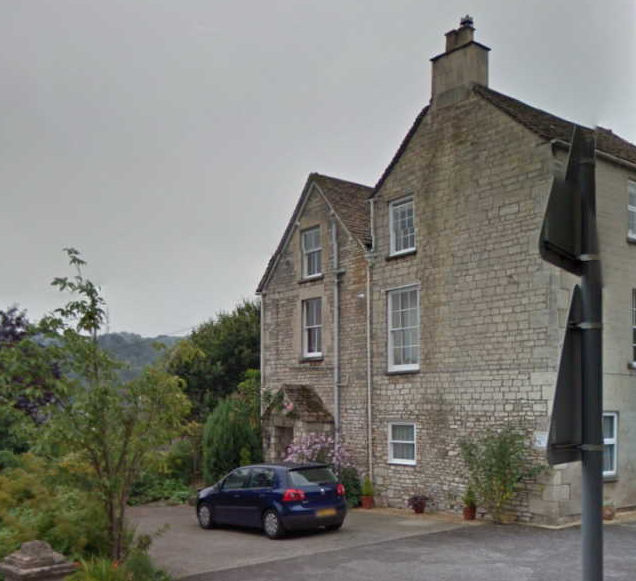
Figure 2. Chestnut Hill House.
(Image
courtesy of Sara Salome Mathews)
Education
Henry attended Wycliffe College from 1882 to 1884. He entered Clifton College in 1885 and became the Commanding Officer of the Clifton College Officer’s Training Corps. In 1889 he left Clifton College to attend Trinity College of the University of Cambridge, where he graduated in 1893. In 1894 he returned to Clifton College as a Science Master and in 1901 he became an Assistant School Master at Clifton College residing at Hallward’s, 30 College Road in Clifton, Bristol, Gloucestershire.[2]
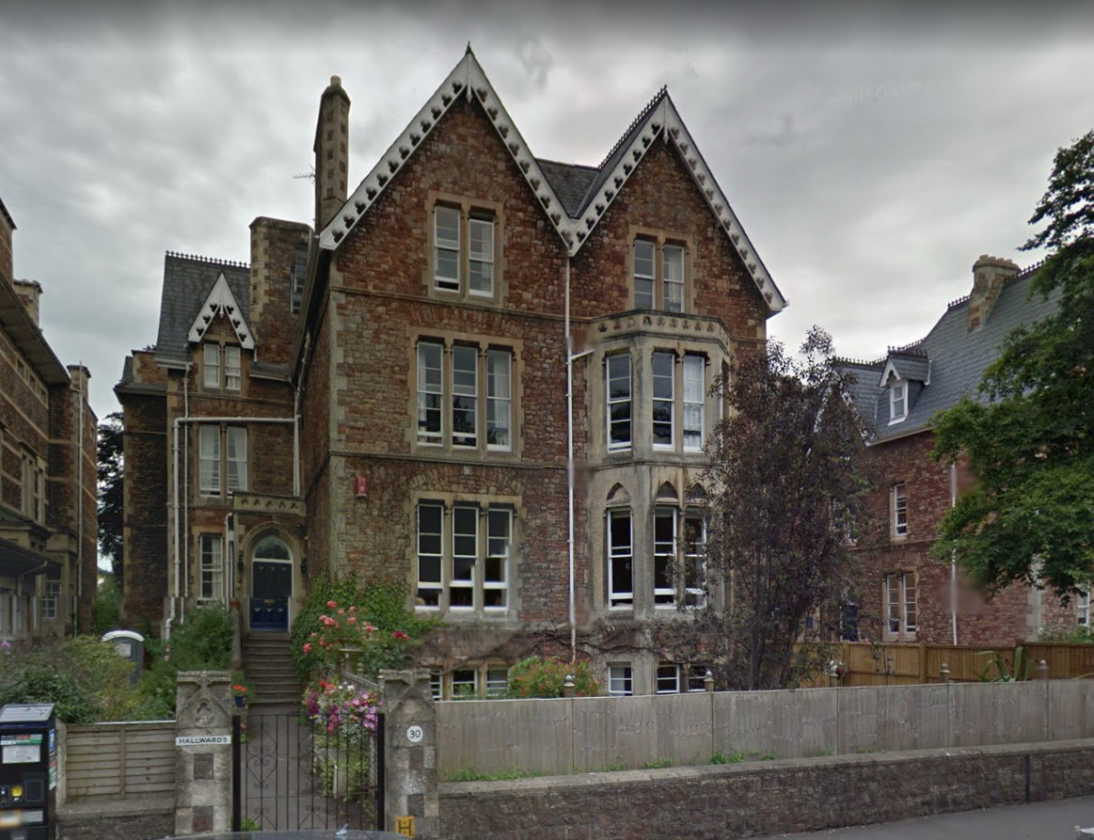
Figure 3. 30 College Road, Bristol, Gloucestershire.
(Image
courtesy of Google Earth)
By 1911 Clissold was a School Master at Clifton College with a residence at 42 College Road and in 1912 he became a House Master at the college.[3]
3. COMMISSIONING AND TRAINING
In August of 1914 when the Great War began, the units of the South Midland Division had just departed for annual summer camp when emergency orders recalled them to their home bases. All units were mobilised for full time war service on 5 August 1914 and moved to concentrate in the Chelmsford area by mid-August 1914.[4]
Commissioning
On 29 September 1914, because of his many years of experience with the Officer Training Corps at Clifton College, Clissold was asked to raise and train a new field company for the South Midland Division. At the time he was 43 years old and was a Major on the Unattached List of the Territorial Force. On 29 September he was appointed a Temporary Major in the Royal Engineers with precedence on this date as Major.
While working with the Officer Training Corps it became known to many that soldiering was a very exact science with him. It was characteristic of him to shoulder the responsibilities of the Clifton College Corps and set out to make himself the “compleat soldier,” spending holiday after holiday at Chatham, Gosport, Exmoor, Aldershot or on the Salisbury Plain, where he perfected himself in the duties of an engineer and infantry soldier.[5] It was these attributes and his desire to be the best that he could be that were instrumental of his being appointed to raise a field company of Royal Engineers.
Training
With more than 29 years of experience with the Clifton College Officer Training Corps it was felt by the War Office that he was suitable to command a field company. Between September and December of 1914 he raised and trained the 1st South Midlands Field Company, R.E. (T.F.) and prepared it to join the 27th Division.[6] The 27th Division was formed in late 1914 by combining various Regular Army units that had been acting as garrisons about the British Empire.
The company’s stay with the 27th Division was a short one, but on 15 February 1915 the company lost its first man. 1052 Sapper William Edward Parsons died while in training presumably from an accident or by an illness. This was Major Clissold’s first experience with the loss of one of his men, but it would not be the last.
4. POSTINGS AND CAMPAIGN SERVICE
In March 1915 Clissold’s company joined the 3rd Division briefly and in April 1915 it was assigned to the 5th Division, again for a very short time. On 11 April 1915 the company went to France to join the 48th (South Midland) Division and it would remain with this division for the duration of the war.[7]
On 3 June 1916 London Gazette Issue 29608 announced the award of the Distinguished Service Order (DSO) to Clissold stating that “His Majesty the King has been graciously pleased to approve the award for the Distinguished Service in the Field.” This award was presented as part of the King’s Birthday Honours for 1916 and had to be based on Clissold’s long service with the Officers Training Corps and his rapid and efficient raising of the 1st South Midlands Field Company.
The company’s War Diary, dated 1 October 1916 at Gaudiempre, also lists Clissold’s award along with another DSO (Major E. Gardner), two Military Crosses, two Distinguished Conduct Medals, three Military Medals and five Mentions in Despatches to men of the company.
The Somme (1 July to 18 November 1916)
During 1916 the 1st South Midlands Field Company, in support of the 48th Division, took part in the following actions:
Battle of Bazentin Ridge (14-17 July 1916)
The Battle of Bazentin Ridge was part of the Battle of the Somme. On 14 July, the British Fourth Army (General Henry Rawlinson) made a dawn attack against the German 2nd Army (General Fritz von Below) in the Brown Position (Braune Stellung), from Delville Wood westwards to Bazentin le Petit Wood. During this battle the 48th Division captured the town of Ovillers.[8]
Battle of Pozières (23 July – 3 September 1916)
This battle took place in northern France around the village of Pozières, during the Battle of the Somme. The costly fighting ended with the British in possession of the plateau north and east of the village, in a position to menace the German bastion of Thiepval from the rear. In the fighting around Pozières the 48th Division suffered 2,700 casualties from 16–28 July and 2,505 more from 13 August.[9] Clissold’s company did not suffer any casualties during this battle.
Battle of the Ancre Heights (1 October – 11 November 1916)
The Battle of the Ancre Heights is the name given to the continuation of British attacks after the Battle of Thiepval Ridge from 26 to 28 September during the Battle of the Somme. The battle was conducted by the Reserve Army (renamed Fifth Army on 29 October) from Courcelette near the Albert–Bapaume road, west to Thiepval on Bazentin Ridge. British possession of the heights would deprive the German 1st Army of observation towards Albert to the south-west and give the British observation north over the Ancre valley to the German positions around Beaumont-Hamel, Serre and Beaucourt. The Reserve Army conducted large attacks on 1, 8, 21, and 25 October and from 10 to 11 November.[10] Although the 48th Division did not take a prominent part in this battle, Clissold’s company lost one man, 3088 Sapper Stanley Frederick Pasker, who was killed in action on 13 October.[11]
Battle of the Ancre (13-18 November 1916)
The Battle of the Ancre was fought by the British Fifth Army (Lieutenant-General Hubert Gough), against the German 1st Army (General Fritz von Below). The Reserve Army had been renamed the Fifth Army on 30 October. The battle was the last of the big British attacks of the Battle of the Somme. After the Battle of Flers–Courcelette (15–22 September) the Anglo-French armies tried to press their advantage with smaller attacks in quick succession, rather than pausing to regroup and give the Germans time to recover.[12] The 48th Division provided a supporting role in this battle. Clissold’s company did not suffer any casualties.
SPRING (JANUARY – JULY 1917)
On 13 January 1917 Major Clissold was called up to act as the Commander Royal Engineers for the 48th Division while his company was at Pont Remy. His stay at division headquarters was a short one and he returned to the company on 17 January. On 20 January he went to the Fourth Army School of Instruction at Le Pareg for a Commanding Officer’s Course.[13]
On 13 March 1917 Major Clissold was attached to the staff of the Commander Royal Engineers at 48th Division headquarters. The reason for this attachment is not known, but presumably it was to assist the CRE in developing plans for operations of the divisional engineers. During this period his company was involved with the construction of a heavy trestle bridge at La Mire, a bridge that Clissold had designed. Clissold returned to his company from 48th Division headquarters on 13 April and assumed his normal command duties. He moved the company headquarters to Le Bucquieres on 17 May and on 25 May he left on leave. He returned from leave on 8 June, but while he was away his company lost another man due to enemy action. On 4 June 1917, 494848 Sapper Albert Ernest Arbury was killed. It should be noted that by this time the 1st South Midland Field Company had been redesignated the 474th (South Midland) Field Company, thereby giving it a numerical designation in line with the Regular Army field companies. The men in the company also were given new regimental numbers in the range 494XXX to 496XXX, as was the case with Sapper Arbury.
The CRE called Major Clissold to division headquarters again on 15 June. One may assume that Clissold’s experience as a field company commander and his expertise in field engineering were considered to be of considerable value to the CRE. The CRE had other Royal Engineers field companies under his control. These included the 475th (2nd South Midland) Field Company, the 419th (1st West Lancashire) Field Company and the 476th (2/1st South Midland) Field Company. Like the 474th, the 475th Field Company had been with the division since its creation. The 419th had only been attached from 18-28 April 1915 and the 476th joined the division in June 1915. For a while the 48th Division CRE even had control of the 7th Field Company (joined April 1915, left June 1915), one of the Regular Army companies.[14] All the other units had come from the Territorial Force. With all this talent in the division, it is still to Major Clissold’s credit that he was chosen to assist the CRE on a number of occasions.
Although the 48th Division was not heavily involved again in action against the enemy until mid-August, the 474th Field Company was not without casualties. On 7 July 1917, 494334 Driver Charles George Lansdown was killed in action and on 18 July 179093 Sapper Frank Hayton was killed.[15] These isolated casualties were probably caused by enemy artillery fire on the company’s work sites.
On 10 August 1917, while the company was preparing for the Battle of Langemarck, 494404 Driver Frederick Charles Lawrence was killed in action.[16] Drivers were vulnerable to enemy artillery fire while moving supplies on open roads. But Lawrence death was only the beginning of the large number of casualties to be suffered by the company.
Battle of Langemarck (16-18 August 1917)
The Battle of Langemarck was the second Anglo-French general attack of the Third Battle of Ypres. The battle took place near Ypres in Flanders against the German 4th Army. The French First Army had a big success on the northern flank from Bixschoote to Drie Grachten (Three Canals) and the British gained a substantial amount of ground northwards from Langemark to the boundary with the French.[17]
The attack on the Gheluvelt Plateau on the right (southern) flank captured a considerable amount of ground but failed to reach its objectives. German counter-attacks recaptured most of the lost territory during the afternoon. The weather prevented much of the British program of air co-operation with the infantry, which made it easier for German reserves to assemble on the battlefield.[18]
The 48th (South Midland) Division, under XVIII Corps, attacked at 0445 hours on 16 August with one brigade, capturing Border House and gun pits either side of the north-east bearing St Julien–Winnipeg road, where they were held up by machine-gun fire and a small counter-attack. The capture of St Julien was completed and the infantry consolidated along a line from Border House to Jew Hill, the gun pits and St Julien. Troops were fired on from Maison du Hibou and Hillock Farm, which was captured soon after, then British troops seen advancing on Springfield Farm disappeared. At 0900 hours German troops gathered around Triangle Farm and at 1000 hours made an abortive counter-attack. Another German attack after dark was defeated at the gun pits and at 2130 hours a German counter-attack from Triangle Farm was repulsed. On 17 August a 48th (South Midland) Division attack on Maison du Hibou failed.[19] During the battle 494090 2nd Corporal Albert Edward Edmonds was killed.[20]
In actions subsequent to the battle the 474th Field Company lost five more men killed in action. They were, on 21 August:[21]
┼ 554407 Sapper Thomas William Bent
┼ 551154 Sapper Reuben Dore
┼ 494539 Sapper Sidney Charles Parsons
┼ 477022 Sapper Percy Relph
On 24 August, 496751 Sapper W.E.D. Townsend killed in action and on the following day Major Clissold was slightly wounded and was admitted to the 61st Casualty Clearing Station (2/1st South Midland) (Territorial Force).[22] This CCS had arrived by rail at Proven on 5 June 1917 and had set up at Dozinghem. On 17 and 20 August 1917 the site came under enemy aerial bombardment, sustaining total 34 casualties.[23] The 474th Field Companies wounded at Langemarck in August 1917 included 41 Other Ranks and on 8 September 494899 Sapper Arthur Cocks died of wounds. (See complete list of company casualties, August 1917 in Annex A).[24]
On 17 September 1917 Major Clissold and Lieutenant Watson, one of his company subalterns, went to Zutkerque to attend an engineer training course. They returned to the company in time for the opening of the Battle of Polygon Wood on 26 September. The Battle of Polygon Wood took place from 26 September to 3 October 1917, during the second phase of the Third Battle of Ypres. The battle was fought near Ypres in the area from the Menin road to Polygon Wood and thence north, to the area beyond St Julien. Much of the woodland had been destroyed by the huge quantity of shellfire from both sides since 16 July and the area had changed hands several times.[25]
During the battle the 474th Field Company was in the reserve line. On 28 September Major Clissold was at California Trench in Peselhoek, near Poperinge sheltering in a dug-out during a heavy German artillery barrage on his position. A large shell scored a direct hit on the shelter, penetrated the roof and exploded inside. Major Harry Clissold, age 46, was killed along with four Sappers and 17 others were wounded by the same shell, two of them fatally.[26] The men of the company killed with Major Clissold were:[27]
┼ 546782 Sapper Alfred Arthur Allen
┼ 494158 Sapper William John Barber
┼ 494182 Acting Corporal William Joseph Bubb
┼ 446962 Sapper Laurence Meager – died of wounds on 28 September
┼ 188153 Sapper Thomas Christopher Venable – died of wounds on 30 September
Clissold was the only officer of the 47th Field Company to be killed during the war. He was buried at Duhallow Advanced Dressing Station Cemetery near Ypres.[28] See the complete list of company fatalities in Annex B.
In addition to the Distinguished Service Order, Clissold was posthumously awarded the 1914-15 Star, British War Medal and Victory Medal with Mention in Despatches oak leaf. These were sent to his sister, Miss Mabel Elizabeth Clissold of 1 Albert Road, Clifton, Bristol.[29]
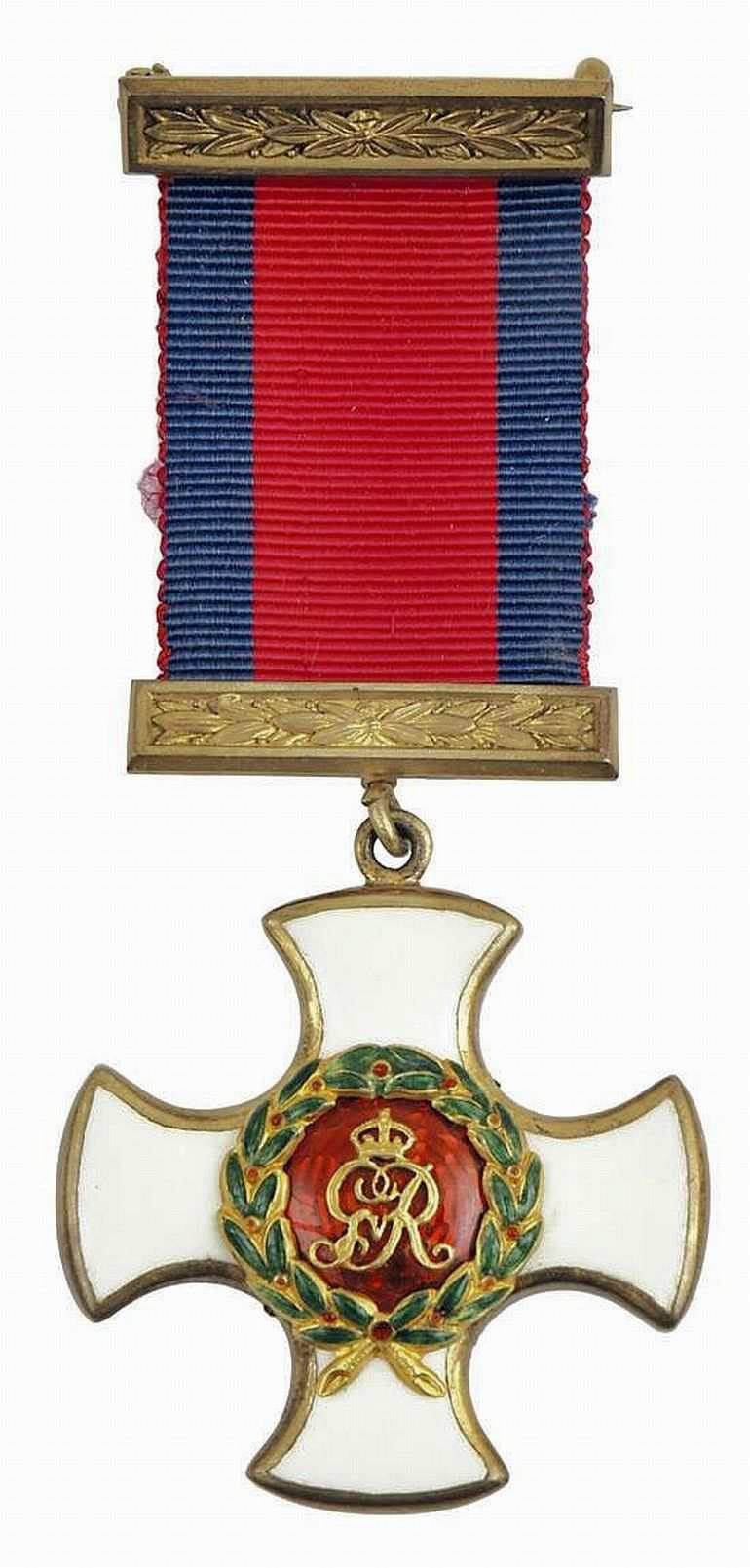
Figure 4. The Distinguished Service Order
(Image courtesy of Wikipedia)
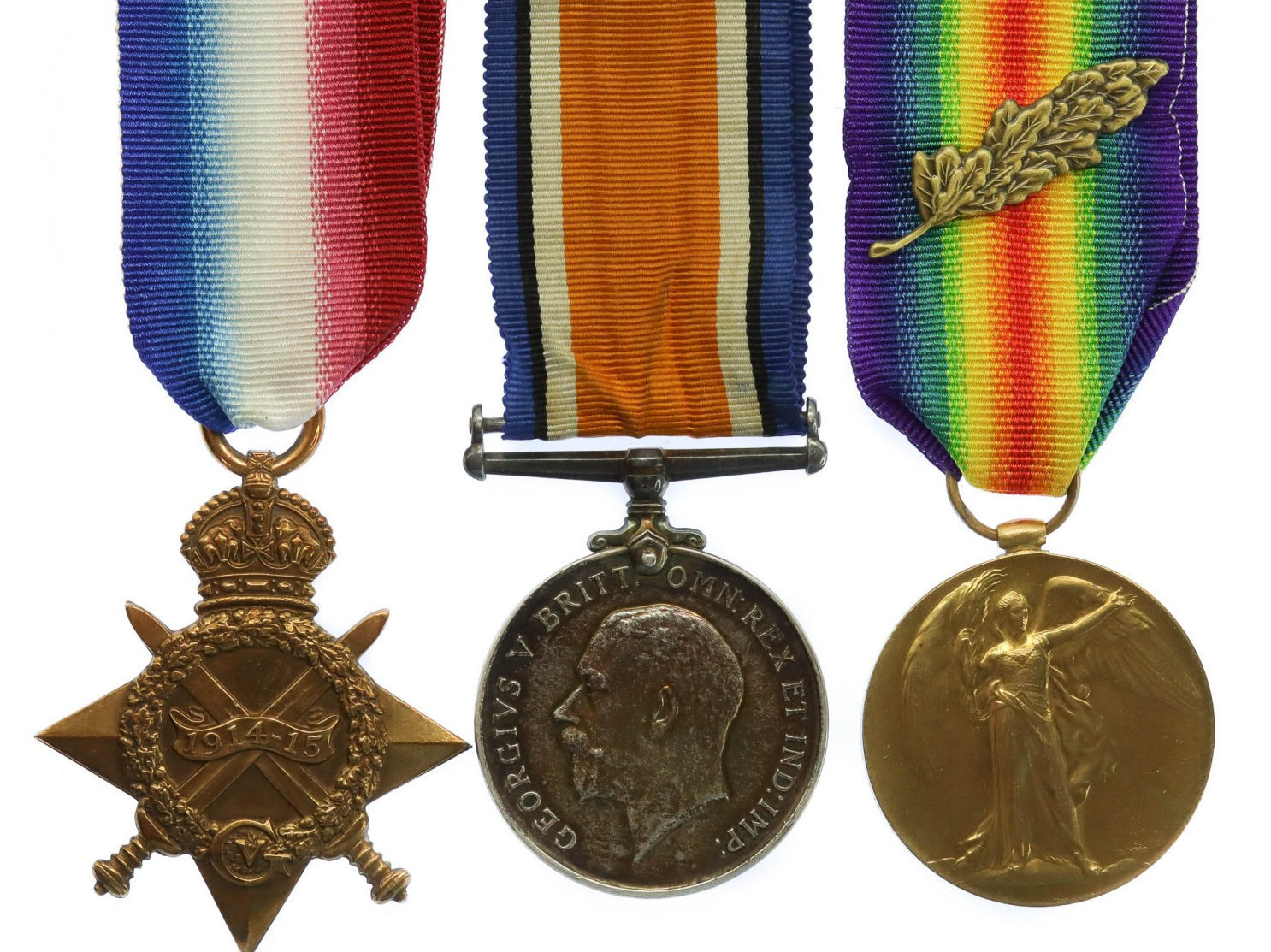
Figure 5. The 1914-15 Star, British War Medal and Victory Medal.
(Image from the author’s collection)
NOTE: The medals shown above are not Major Clissold’s medals. They are presented here for illustrative purposes only.
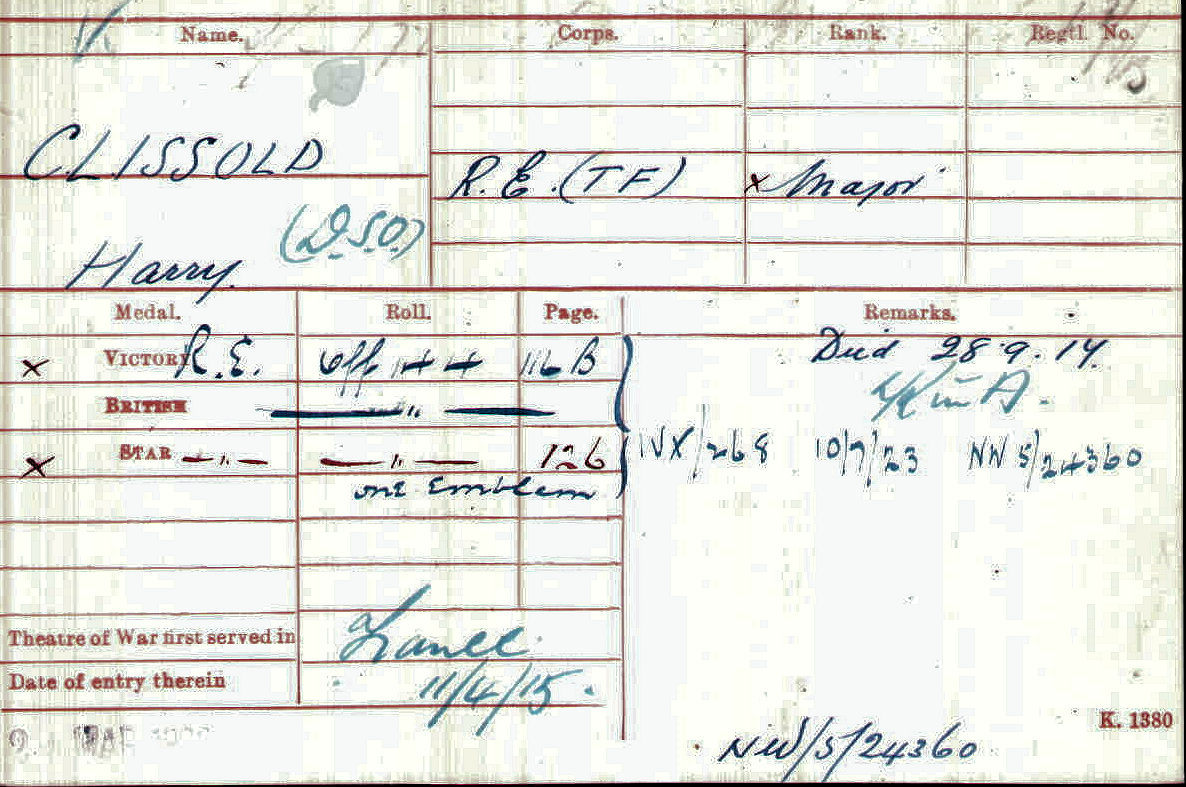
Figure 6. The Medal Index Card of Major Harry Clissold,
D.S.O., R.E.
(Image courtesy of Ancestry.com)
At the time of his death, Harry Clissold’s residence was 1 Albert Road, Clifton, Bristol, Gloucestershire. Probate of his will took place in London on 6 December 1917 with his effects going to his sister, Mabel Elizabeth Clissold, a spinster. His effects amounted to £3,484, 13 shillings and 9 pence, or about $284,200 US in 2023 currency.
ANNEX A
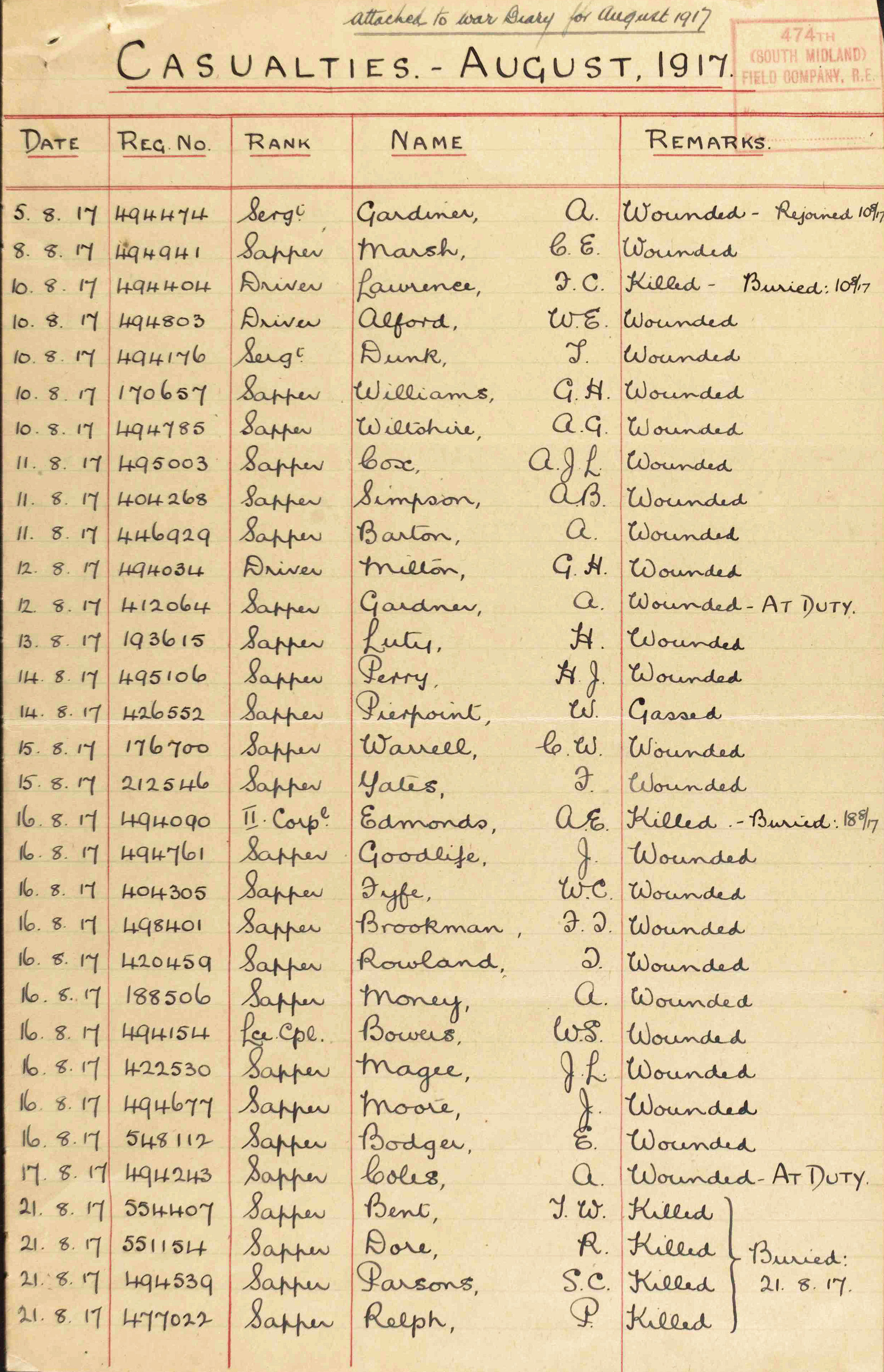
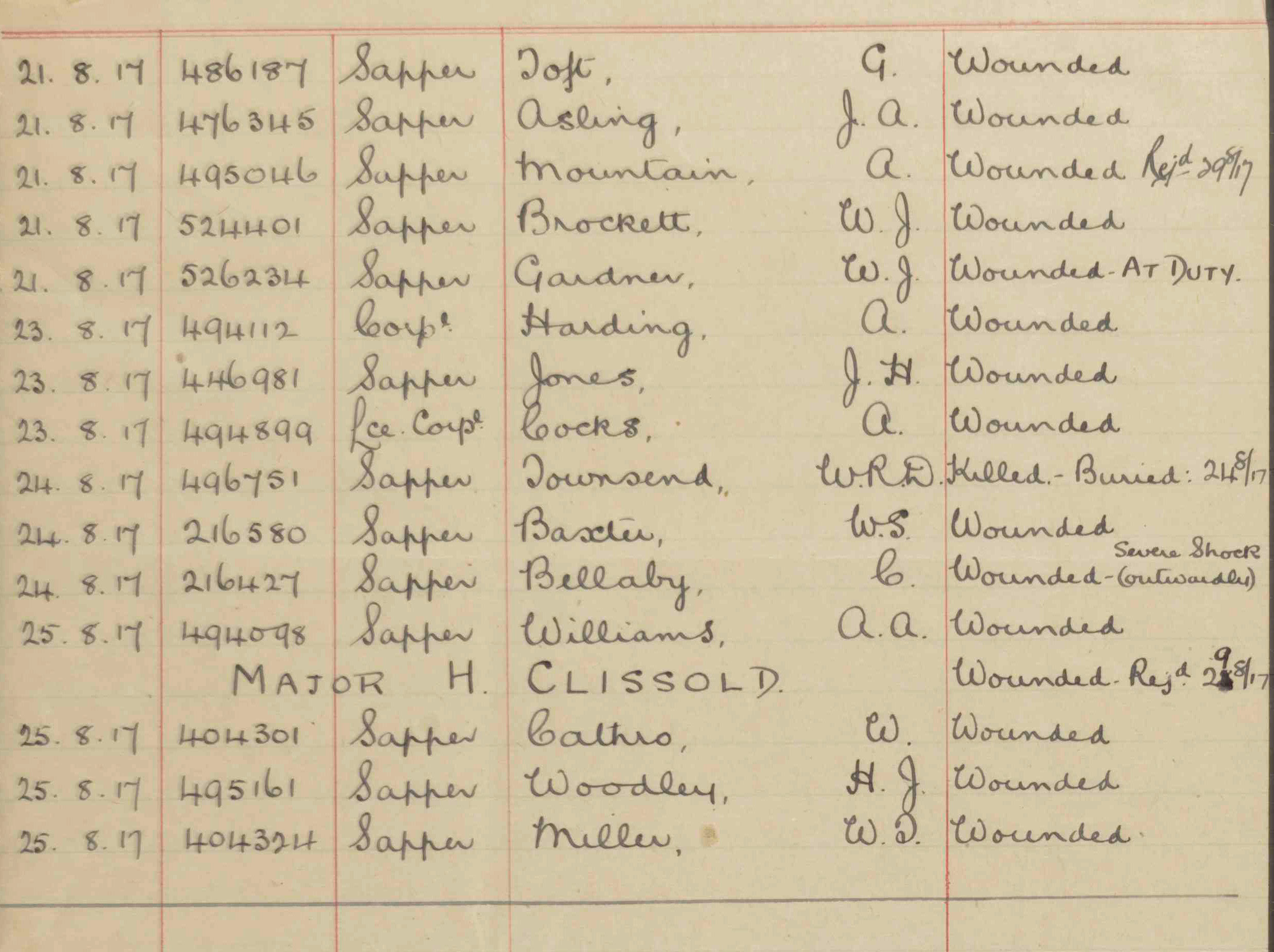
Figure 7. Casualties of the 474th
Field Company During August 1917.
(Image from the company
War Diary)
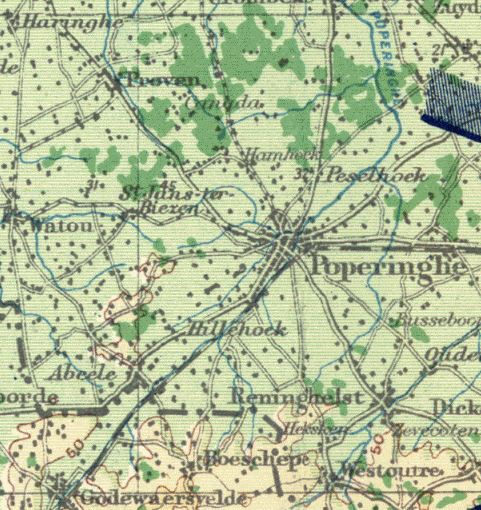
Figure 8. The Peselhoek Area, near Poperinge, where Major Clissold was Killed.
(Image courtesy of Wikipedia)
ANNEX
B
Casualties of the 474th (1st
South Midland) Field Company, Royal Engineers From 1915 to 1920
Name |
Regimental Number |
Rank |
Cause Of Death |
Date of Death |
Parsons, William Edward |
1052 |
Sapper |
KIA |
15 Feb 1915 |
Pasker, Stanley Frederick |
3088 |
Sapper |
KIA |
13 Oct 1916 |
Arbury, Albert Ernest |
494848 |
Sapper |
KIA |
4 Jun 1917 |
Lansdown, Charles George |
494334 |
Driver |
KIA |
7 Jul 1917 |
Hayton, Frank |
179093 |
Sapper |
KIA |
18 Jul 1917 |
Lawrence, Frederick Charles |
494404 |
Driver |
KIA |
10 Aug 1917 |
Edmonds, Albert Edward |
494090 |
2nd Corporal |
KIA |
16 Aug 1917 |
Bent, Thomas William |
554407 |
Sapper |
KIA |
21 Aug 1917 |
Dore, Reuben |
551154 |
Sapper |
KIA |
21 Aug 1917 |
Parsons, Sidney Charles |
494539 |
Sapper |
KIA |
21 Aug 1917 |
Relph, Percy |
477022 |
Sapper |
KIA |
21 Aug 1917 |
Townsend, W.R.D. |
496751 |
Sapper |
KIA |
24 Aug 1917 |
Cocks, Arthur |
494899 |
Sapper |
DOW |
8 Sep 1917 |
Allen, Alfred Arthur |
546782 |
Sapper |
KIA |
28 Sep 1917 |
Barber, William John |
494158 |
Sapper |
KIA |
28 Sep 1917 |
Bubb, William Joseph |
494182 |
A/Corporal |
KIA |
28 Sep 1917 |
Clissold, Henry |
|
Major |
KIA |
28 Aug 1917 |
Meager, Laurence (Bob) |
446962 |
Sapper |
DOW |
28 Sep 1917 |
Venable, Thomas Christopher |
188153 |
Sapper |
DOW |
30 Sep 1917 |
Heath, J.H. |
494169 |
Driver |
Died |
20 Mar 1920 |
Legend: KIA – Killed in Action; DOW – Died of Wounds; Died – of disease or accidentally killed.
NOTES:
Sappers Parsons, W.E. and Pasker, S.F. were killed early in the war and still had their Territorial Force Regimental Number when the company was still the 1st South Midland Field Company.
Following the redesignation of the company to the 474th Field Company, the men were issued Regimental Numbers in the 494000 to 496000 series. Ten of the 19 (52.6%) Other Ranks casualties above have numbers in this series.
Driver Heath died at home, perhaps of the Spanish flu.
The following is a statistical analysis of these deaths by various categories:
1. Total Company Casualties from all Causes: 20
2. Deaths by Rank
Major 1
Corporals 1
2nd Corporals: 1
Sappers: 14
Drivers: 3
3. Deaths by Category
Killed in Action: 16
Died of Wounds: 3
Died of Disease or Accident: 1
3. Deaths by Year
1915: 1
1916 1
1917: 17
1920: 1
REFERENCES:
Books
Wycliffe and the War: A School Record. John Bellows, Gloucester, 1923, 30-32.
Census
1871 Census of England (RG 10/2640).
1881 Census of England (RG 11/2550).
1891 Census of England (RG 12/2028).
1901 Census of England (RG 13/2368).
1911 Census of England and Wales.
Civil Documents
Obituary, Western Dailey Press, 9 October 1917.
Family Trees
The Clissold Family Tree by Sara Salome Mathews.
Internet Web Sites
The Long, Long Trail: Field Companies of the Royal Engineers
Imperial War Museum, Lives of the First World War
https://livesofthefirstworldwar.iwm.org.uk/lifestory/862713
Nailsworth Town Council
https://www.nailsworthtowncouncil.gov.uk/ww1/soldier.php?Sequence=19
Commonwealth War Graves Commission
The Long, Long Trail: 48th (South Midland) Division.
https://www.longlongtrail.co.uk/army/order-of-battle-of-divisions/48th-south-midland-division/
London Gazette
The London Gazette, 19 January 1915, p. 613.
Supplement to the London Gazette, 8 June 1916, pp. 5566 and 5567.
Supplement to the London Gazette, 30 July 1917, p. 7785.
Military Documents
Medal Roll, 1914-15 Star
Medal Roll, British War Medal and Victory Medal
Medal Index Card
War Diary, 474th Field Company, R.E. (Army Form C. 2118).
b. 13-20 January 1917.
c. 8-13 March 1917.
d. 20-28 March 1917.
e. 11-29 April 1917.
f. 16-31 May 1917.
g. 1-20 June 1917.
h. 22-26 August 1917.
i. Casualties – August 1917.
j. 1-18 September 1917.
k. 19-30 September 1917.
l. 1-13 October 1917.
Periodicals
Battle Honours of the Royal Engineers. The Royal Engineers Journal. The Institution of Royal Engineers, Chatham, Kent, 1925-1932.
ENDNOTES:
[1] Justice of the Peace and Companion of the Order of Canada.
[2] Clissold Family Tree.
[3] Ibid.
[4] The Long, Long Trail.
[5] Obituary: Western Dailey Press.
[6] The London Gazette, 19 January 1915.
[7] Clissold’s Medal Index Card.
[8] Wikipedia.
[9] Ibid.
[10] Ibid.
[11] Commonwealth War Graves Commission (CWGC).
[12] Wikipedia.
[13] Company War Diary.
[14] The Long, Long Trail.
[15] CWGC. It should be noted that Hayton’s regimental number 179093 is out of sequence with the majority of the numbers issued to men of the company. This indicates that he was a replacement from another unit.
[16] CWGC.
[17] Wikipedia.
[18] Ibid.
[19] Ibid.
[20] Company War Diary.
[21] CWGC.
[22] Company War Diary.
[23] The Long, Long Trail.
[24] Company War Diary.
[25] Wikipedia.
[26] Clissold Family Tree.
[27] CWGC.
[28] Ibid.
[29] Medal Index Card.